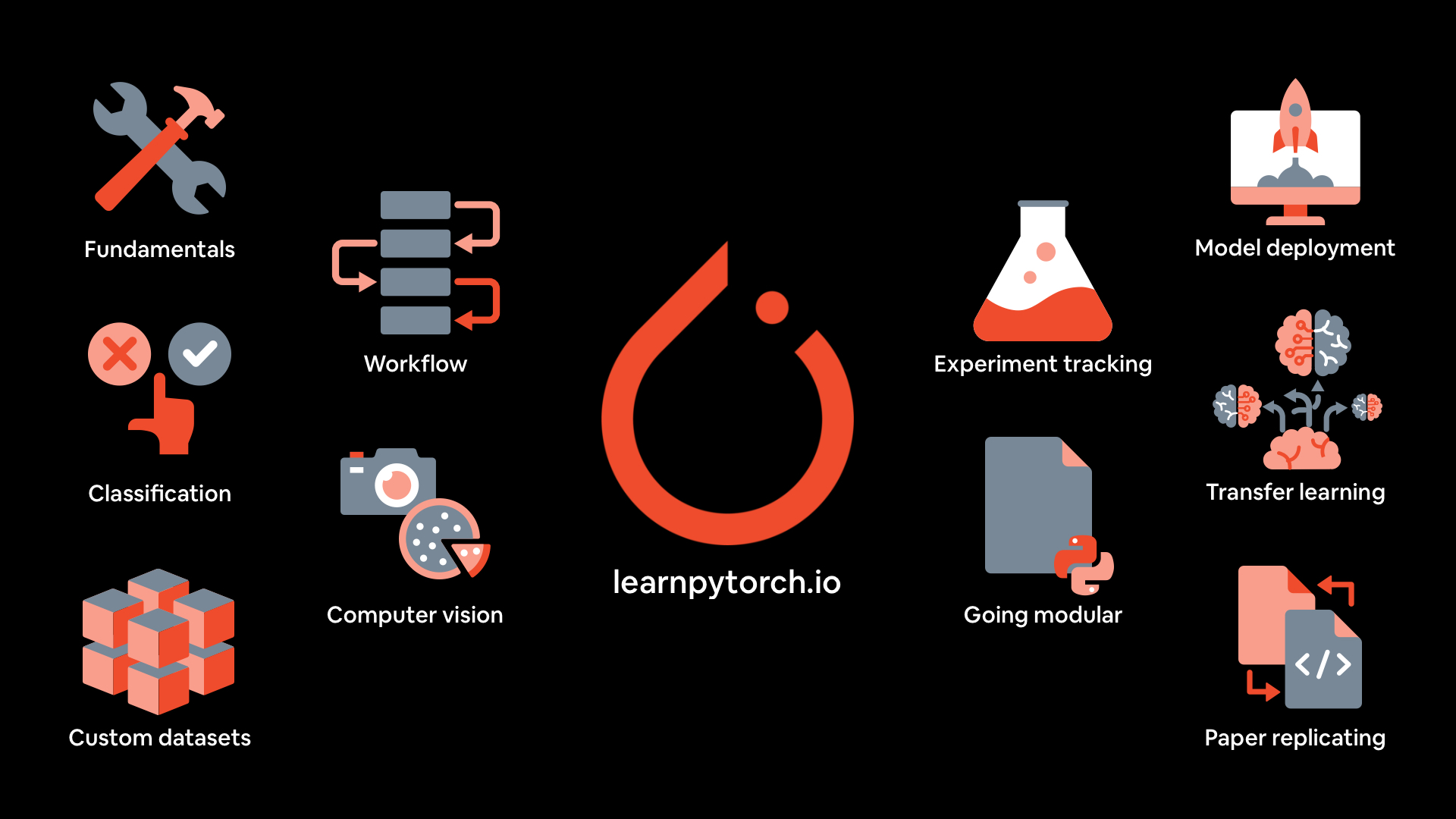Overview#
Adapted from Learn PyTorch for Deep Learning: Zero to Mastery, the second best place to learn PyTorch on the internet (the first being the PyTorch documentation).

pytorch deep learning by zero to mastery cover photo with different sections of the course
Course materials/outline#
📖 Online book version: All of the course materials are available in a readable online book at learnpytorch.io.
🎥 First five sections on YouTube: Learn Pytorch in a day by watching the first 25-hours of material.
🔬 Course focus: code, code, code, experiment, experiment, experiment.
🏃♂️ Teaching style: https://sive.rs/kimo.
🤔 Ask a question: See the GitHub Discussions page for existing questions/ask your own.
See the project page for work-in-progress board
Section |
What does it cover? |
Exercises & Extra-curriculum |
Slides |
|---|---|---|---|
Many fundamental PyTorch operations used for deep learning and neural networks. |
|||
Provides an outline for approaching deep learning problems and building neural networks with PyTorch. |
|||
Uses the PyTorch workflow from 01 to go through a neural network classification problem. |
|||
Let’s see how PyTorch can be used for computer vision problems using the same workflow from 01 & 02. |
|||
How do you load a custom dataset into PyTorch? Also we’ll be laying the foundations in this notebook for our modular code (covered in 05). |
|||
PyTorch is designed to be modular, let’s turn what we’ve created into a series of Python scripts (this is how you’ll often find PyTorch code in the wild). |
|||
Let’s take a well performing pre-trained model and adjust it to one of our own problems. |
|||
We’ve built a bunch of models… wouldn’t it be good to track how they’re all going? |
|||
PyTorch is the most popular deep learning framework for machine learning research, let’s see why by replicating a machine learning paper. |
|||
So we’ve built a working PyTorch model… how do we get it in the hands of others? Hint: deploy it to the internet. |
|||
This course covers a large amount of PyTorch and deep learning but the field of machine learning is vast, inside here you’ll find recommended books and resources for: PyTorch and deep learning, ML engineering, NLP (natural language processing), time series data, where to find datasets and more. |
- |
- |
|
A very quick overview of some of the main features of PyTorch plus links to various resources where more can be found in the course and in the PyTorch documentation. |
- |
- |
About this course#
Who is this course for?#
You: Are a beginner in the field of machine learning or deep learning and would like to learn PyTorch.
This course: Teaches you PyTorch and many machine learning concepts in a hands-on, code-first way.
If you already have 1-year+ experience in machine learning, this course may help but it is specifically designed to be beginner-friendly.
What are the prerequisites?#
3-6 months coding Python.
At least one beginner machine learning course (however this might be able to be skipped, resources are linked for many different topics).
Experience using Jupyter Notebooks or Google Colab (though you can pick this up as we go along).
A willingness to learn (most important).
For 1 & 2, I’d recommend the Zero to Mastery Data Science and Machine Learning Bootcamp, it’ll teach you the fundamentals of machine learning and Python (I’m biased though, I also teach that course).
How is the course taught?#
All of the course materials are available for free in an online book at learnpytorch.io. If you like to read, I’d recommend going through the resources there.
If you prefer to learn via video, the course is also taught in apprenticeship-style format, meaning I write PyTorch code, you write PyTorch code.
There’s a reason the course motto’s include if in doubt, run the code and experiment, experiment, experiment!.
My whole goal is to help you to do one thing: learn machine learning by writing PyTorch code.
The code is all written via Google Colab Notebooks (you could also use Jupyter Notebooks), an incredible free resource to experiment with machine learning.
What will I get if I finish the course?#
There are certificates and all that jazz if you go through the videos.
But certificates are meh.
You can consider this course a machine-learning momentum builder.
By the end, you’ll have written hundreds of lines of PyTorch code.
And will have been exposed to many of the most important concepts in machine learning.
So when you go to build your own machine learning projects or inspect a public machine learning project made with PyTorch, it’ll feel familiar and if it doesn’t, at least you’ll know where to look.
What will I build in the course?#
We start with the barebone fundamentals of PyTorch and machine learning, so even if you’re new to machine learning you’ll be caught up to speed.
Then we’ll explore more advanced areas including PyTorch neural network classification, PyTorch workflows, computer vision, custom datasets, experiment tracking, model deployment, and my personal favorite: transfer learning, a powerful technique for taking what one machine learning model has learned on another problem and applying it to your own!
Along the way, you’ll build three milestone projects surrounding an overarching project called FoodVision, a neural network computer vision model to classify images of food.
These milestone projects will help you practice using PyTorch to cover important machine learning concepts and create a portfolio you can show employers and say “here’s what I’ve done”.
How do I get started?#
You can read the materials on any device but this course is best viewed and coded along within a desktop browser.
The course uses a free tool called Google Colab. If you’ve got no experience with it, I’d go through the free Introduction to Google Colab tutorial and then come back here.